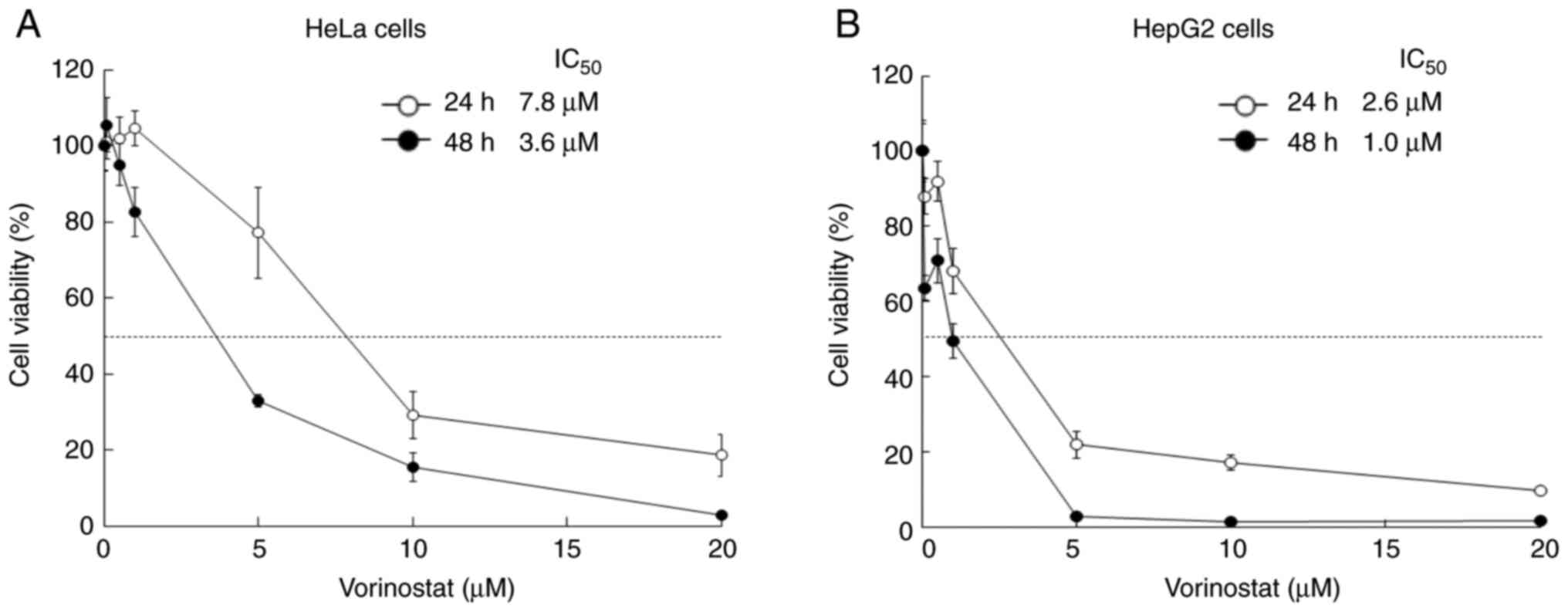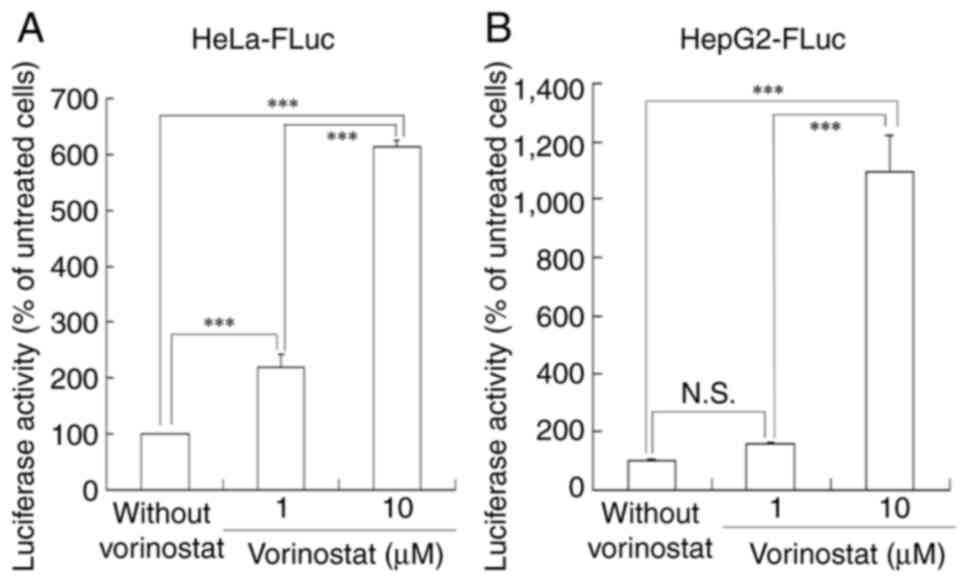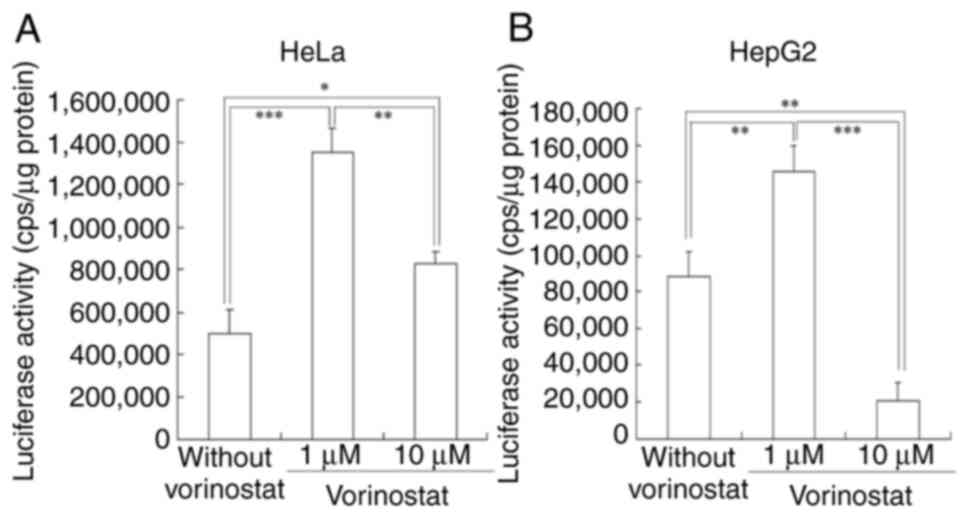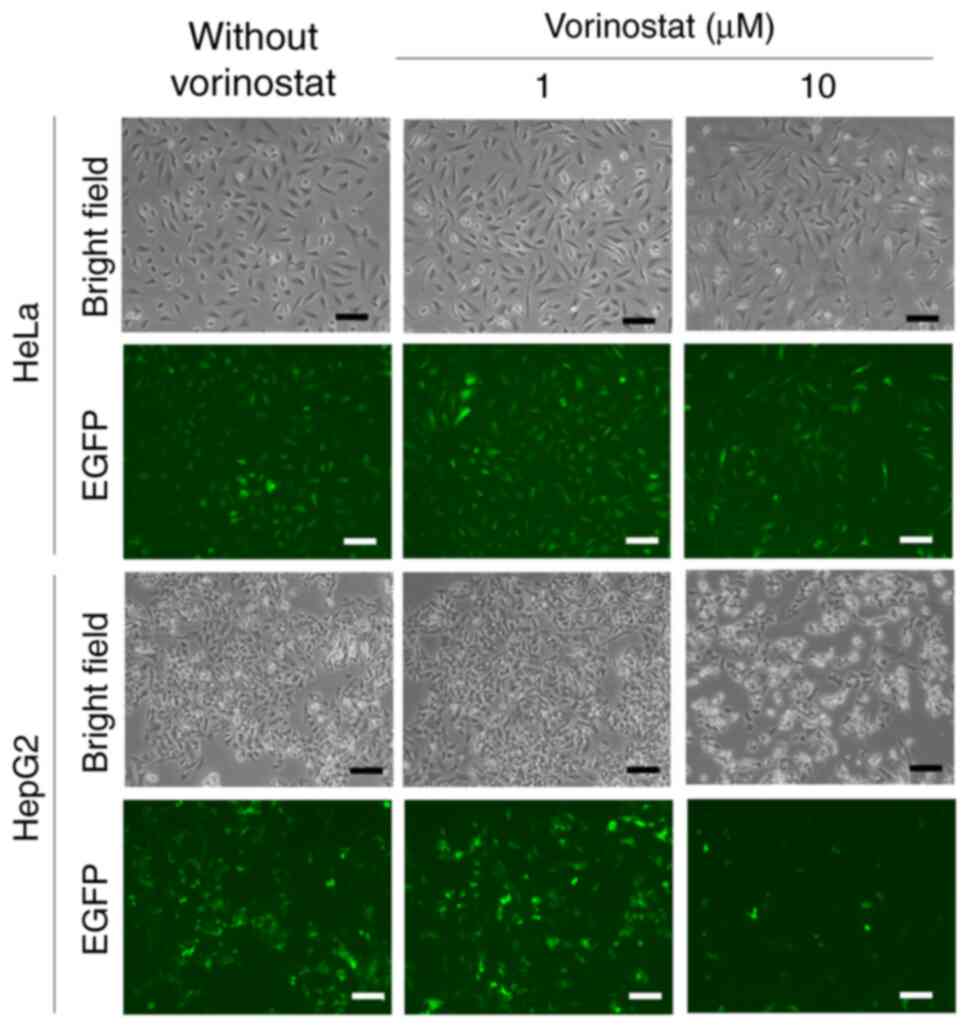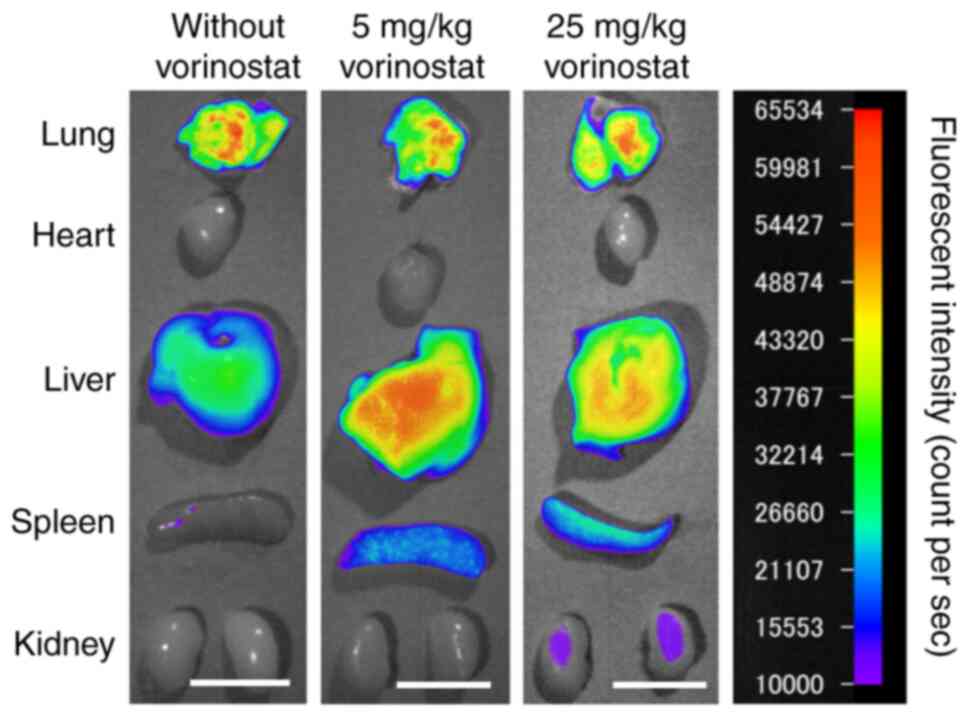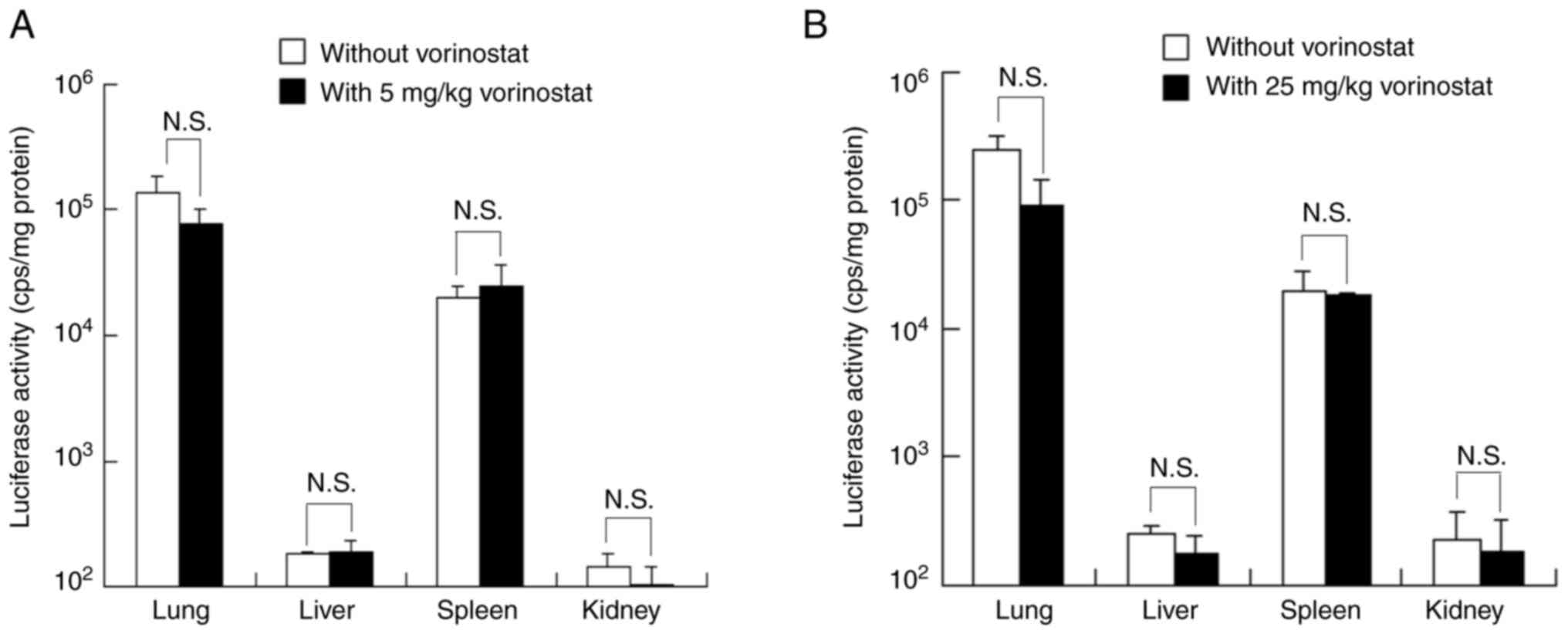Effect of vorinostat on protein expression in vitro and in vivo following mRNA lipoplex administration
- Authors:
- Published online on: May 27, 2024 https://doi.org/10.3892/br.2024.1793
- Article Number: 105
-
Copyright: © Tang et al. This is an open access article distributed under the terms of Creative Commons Attribution License.
Abstract
Introduction
mRNA is a single-stranded ribonucleic acid that carries coding sequences for protein synthesis and undergoes translation by ribosomes to produce proteins. mRNA-based therapeutics have emerged as promising ways for promptly and efficiently expressing therapeutic proteins in cells (1). The most advanced application of mRNA therapeutics lies in vaccination against viral infections and tumors (2,3). However, mRNA molecules are susceptible to rapid degradation by extracellular RNases and cannot traverse cellular membranes owing to their negative charge, hydrophilicity and high molecular weight (4). Therefore, the development of efficient and safe mRNA delivery systems is imperative (5-7). Previously, we demonstrated that cationic liposomes, comprising N-hexadecyl-N,N-dimethylhexadecan-1-aminium bromide (DC-1-16), 1,2-dioleoyl-sn-glycero-3-phosphoethanolamine (DOPE) and poly(ethylene glycol) cholesteryl ether (PEG-Chol), induce high protein expression in the lungs and spleen following intravenous administration of mRNA/cationic liposome complexes (mRNA lipoplexes) (8).
Histone deacetylases (HDACs) constitute a family of enzymes recognized as a promising target to reverse aberrant epigenetic states associated with tumors through the regulation of histone acetylation levels (9). HDAC inhibitors elevate acetylation levels within chromatin and treating tumor cells with HDAC inhibitors induces growth arrest or cell death (10). Among the HDAC inhibitors, vorinostat [suberoylanilide hydroxamic acid (SAHA)] stands as the U.S. first food and drug administration (FDA)-approved drug to be used in the treatment of cutaneous T-cell lymphoma (11,12). Additionally, HDAC inhibitors exhibit the capability to enhance transgene expression from both plasmid DNA transiently transfected into cells and transgenes stably transfected into the cell genome via histone acetylation (13,14). Following transfection into cells, plasmid DNA binds to histones in the nucleus, thereby impeding transgene expression through the limited accessibility of transcription factors to the plasmid DNA (13). In stably transfected transgenes, a relaxed chromatin structure becomes imperative for facilitating transgene expression via enhanced transcription factor accessibility (13). Therefore, HDAC inhibitors augment transgene expression by relaxing chromatin structure through histone acetylation.
However, to the to the best of the authors' knowledge, there remains a paucity of reports regarding the effects of HDAC inhibitors on protein expression from transfected mRNA. In the present study, to examine the effect of HDAC inhibitors on protein expression from transfected mRNA, mRNA lipoplexes were prepared for transfection into both tumor cells and mouse tissues and the effect of vorinostat on both in vitro and in vivo protein expression following the administration of mRNA lipoplexes was evaluated.
Materials and methods
Materials
DC-1-16 was obtained from Sogo Pharmaceutical Co., Ltd. DOPE and PEG-Chol (mean molecular weight of PEG: 1600) were purchased from NOF Co., Ltd. Vorinostat (SAHA) was purchased from Combi-Blocks, Inc. All the remaining chemicals were of the highest available grade.
mRNAs
Firefly luciferase (FLuc) mRNA [1929 nt; cat. no. L-7202; CleanCap FLuc mRNA (5 moU)] and enhanced green fluorescent protein (EGFP) mRNA (996 nt; cat. no. L-7601; CleanCap EGFP mRNA) were obtained from TriLink BioTechnologies. Cy5-labeled mRNA [1921 nt; cat. no. R1010; EZCap Cyanine 5 FLuc mRNA (5 moU)] was obtained from ApexBio Technology LLC.
Cell culture
Human cervical carcinoma HeLa cells (cat. no. 93021013; Cellosaurus; CVCL_0030) and human liver cancer HepG2 cells (cat. no. 85011430; Cellosaurus; CVCL_0027) were obtained from the European Collection of Authenticated Cell Cultures. HeLa-FLuc cells, stably expressing pGL3 FLuc (Bioware Cell Line HeLa-luc; Cellosaurus; CVCL_5J41), were obtained from Caliper Life Sciences, Inc. HepG2-FLuc cells, stably expressing pGL3 FLuc (cat. no. JCRB1592; Cellosaurus; CVCL_JG47) were purchased from the JCRB Cell Bank (National Institutes of Biomedical Innovation, Health and Nutrition).
HeLa cells and HeLa-FLuc cells were cultured in Eagle's Minimum Essential Medium (EMEM; FUJIFILM Wako Pure Chemical Corporation) supplemented with 10% heat-inactivated fetal bovine serum (FBS, Thermo Fisher Scientific, Inc.) and 100 µg/ml kanamycin, maintained in an incubator at 37˚C with a 5% CO2 humidified atmosphere. HepG2 and HepG2-FLuc cells were cultured in Dulbecco's Modified Eagle's Medium (DMEM; FUJIFILM Wako Pure Chemical Corporation) supplemented with 10% FBS under the same conditions.
Cytotoxicity of vorinostat on HeLa and HepG2 cells
Vorinostat was initially dissolved in dimethyl sulfoxide (DMSO) at a concentration of 1 mM. This stock solution was diluted with culture medium supplemented with 10% FBS prior to treatment. HeLa and HepG2 cells were then seeded into 96-well culture plates (1x104 cells/well). Following a 24 h incubation period, the cells were treated with 0.1, 0.5, 1, 5, 10, or 20 µM vorinostat. Cell viability was assessed 24 and 48 h post-treatment with vorinostat using a Cell Counting Kit-8 (CCK-8; Dojindo Laboratories, Inc.), as previously described (15). WST-8 substrate was incubated with cells at 37˚C for 60 min. The cell viability (%) was calculated relative to that of untreated cells.
Effect of vorinostat on Luc expression in HeLa-FLuc and HepG2-FLuc cells
HeLa-FLuc and HepG2-FLuc cells were seeded in 12-well culture plates (1x105 cells/well). Following 24 h of incubation, 1 ml of culture medium supplemented with either 1 µM or 10 µM vorinostat was introduced to the HeLa-FLuc or HepG2-FLuc cells. Luc activity [counts per sec (cps)] in the cells was measured 24 h post-transfection with a chemoluminometer (ARVO X2; PerkinElmer, Inc.), as previously described (15). Protein concentrations of the supernatants were determined with bicinchoninic acid (BCA) reagent (Pierce BCA Protein Assay Kit; Pierce; Thermo Fisher Scientific, Inc.), using bovine serum albumin (Thermo Fisher Scientific, Inc.) as a standard and the Luc activity (cps/µg protein) was calculated.
Preparation of mRNA lipoplexes
DC-1-16, DOPE and PEG-Chol were dissolved in chloroform at a molar ratio of 49.5:49.5:1. Chloroform was then evaporated under vacuum using a rotary evaporator set at 60˚C to obtain a thin film. The thin film was hydrated by adding sterilized water at 60˚C, followed by vortexing and subsequent sonication for 10 min at 42 kHz, 100 W and at room temperature in a bath-type sonicator (Bransonic 2510J-MTH; Branson Ultrasonics Corporation). To prepare the mRNA lipoplexes, the cationic liposome suspension was combined with the mRNA solution at a charge ratio (+:-) of 4:1, as described in a previous study (8), thorough vortexing for 10 sec and subsequently left undisturbed at room temperature for 15 min. Particle size distribution and ζ-potential of the mRNA lipoplexes were assessed using a light-scattering photometer (ELS-Z2; Otsuka Electronics Co., Ltd.), as previously described (15).
Effect of vorinostat on Luc expression in HeLa and HepG2 cells following transfection with FLuc mRNA lipoplexes
HeLa and HepG2 cells were seeded into 12-well culture plates (1x105 cells/well). Following incubation at 37˚C for 24 h, FLuc mRNA lipoplexes (0.5 µg mRNA) were diluted in 1 ml of culture medium (EMEM and DMEM for HeLa and HepG2 cells, respectively) containing either 1 or 10 µM vorinostat (final mRNA concentration: 0.5 µg/ml) and added to the cells. At 24 h post-transfection, Luc activity (cps/µg protein) was quantified, as described in the previous section.
Effect of vorinostat on EGFP expression in HeLa and HepG2 cells following transfection with EGFP mRNA lipoplexes
HeLa and HepG2 cells were seeded in 12-well culture plates (1x105 cells/well). Following incubation at 37˚C for 24 h, EGFP mRNA lipoplexes (0.5 µg mRNA) were diluted in 1 ml of culture medium (EMEM and DMEM for HeLa and HepG2 cells, respectively) supplemented with either 1 or 10 µM vorinostat (final mRNA concentration: 0.5 µg/ml) and subsequently introduced to the cells. At 24 h post-transfection, EGFP expression in the cells was observed through fluorescence microscopy, as previously described (8).
Animals
All animal experiments were conducted in accordance with the Guidelines outlined in the Guide for the Care and Use of Laboratory Animals (16), adopted by the Institutional Animal Care and Use Committee of Hoshi University (Tokyo, Japan). Ethical approval was obtained from the Institutional Animal Care and Use Committee of Hoshi University (approval number: P23-108).
A total of 15 female BALB/c mice (20 g, 8 weeks old; Sankyo Labo Service Corporation) were housed under a 12-h light/dark cycle, with lights on from 08:00 a.m. to 08:00 p.m. and provided ad libitum access to food and water. The room temperature was maintained at 24˚C with a relative humidity of 55%.
Effect of vorinostat on mRNA biodistribution following mRNA lipoplex injection in mice
Vorinostat was initially dissolved in DMSO at a concentration of 50 mg/ml. This stock solution was diluted with saline before injection (final concentrations: 1 and 5 mg/ml for doses of 5 and 25 mg/kg, respectively). Vorinostat was administered intraperitoneally to female BALB/c mice at doses of 5 or 25 mg/kg, followed by an intravenous injection of Cy5-labeled mRNA lipoplexes (10 µg mRNA; n=1 per mRNA lipoplex). Following 1 h of intravenous injection, the mice were sacrificed by cervical dislocation under anesthesia induced by isoflurane inhalation (4% for induction and 1.5-2% for maintenance; FUJIFILM Wako Pure Chemical Corporation) and mortality was confirmed by cessation of heartbeat. Cy5 fluorescence images of the lungs, heart, liver, spleen and kidneys were acquired using the NightOWL LB981 NC100 System (Berthold Technologies GmbH & Co. KG), as previously described (8,15).
Effect of vorinostat on Luc expression following FLuc mRNA lipoplex injection in mice
Vorinostat was intraperitoneally administered to female BALB/c mice (8 weeks old) at doses of 5 or 25 mg/kg, followed by intravenous injection of FLuc mRNA lipoplexes (20 µg mRNA; n=3 per group). As described in previous studies (8,17), mice were sacrificed by cervical dislocation under anesthesia induced by isoflurane inhalation at 4 h post-injection of mRNA lipoplexes and the lungs, liver, spleen and kidneys were harvested for analysis. Then 3 µl of ice-cold reporter lysis buffer (cat. no. E3971; Promega Corporation) per 1 mg of tissue were added to each tissue sample and immediately homogenized. Luc activity (cps/mg protein) in the homogenized samples was measured as described in the preceding section.
Statistical analysis
Statistical significance was assessed using the unpaired Student's t-test or one-way analysis of variance, followed by Tukey's post hoc test, employing GraphPad Prism (version 4.0; Dotmatics). P<0.05 was considered to indicate a statistically significant difference.
Results
Cytotoxicity of vorinostat on HeLa and HepG2 cells
Vorinostat, a potent inhibitor of HDAC activity, exhibits antitumor effects on various tumor cells, including those of prostate, ovarian and pancreatic carcinoma (18-20). To investigate the cytotoxicity of vorinostat on HeLa and HepG2 cells, the cells were treated with vorinostat for 24 and 48 h (Fig. 1). The IC50 values of vorinostat for HeLa and HepG2 cells were 7.8 and 2.6 µM, respectively, following 24 h of incubation at 37˚C and 3.6 and 1.0 µM, respectively, following 48 h of incubation at 37˚C.
Effect of vorinostat on Luc activity in HeLa-FLuc and HepG2-FLuc cells
To investigate whether treatment with vorinostat affects Luc expression from a Luc gene inserted into the cellular genome, HeLa-FLuc and HepG2-FLuc cells were treated with either 1 or 10 µM vorinostat, respectively, followed by Luc activity measurement after 24 h of incubation (Fig. 2). Treatment of HeLa-FLuc cells with 1 and 10 µM vorinostat resulted in 2.2- and 6.1-fold higher Luc expression, respectively, compared with untreated cells. Furthermore, treatment of HepG2-FLuc cells with 1 and 10 µM vorinostat led to 1.6- and 11-fold higher Luc expression, respectively, compared with untreated cells. Treatment with 10 µM vorinostat significantly increased Luc activity in both cell lines compared with treatment with 1 µM vorinostat, indicating that concentrations exceeding the IC50 of vorinostat might effectively enhance protein expression from a foreign gene integrated into the genome.
Effect of vorinostat on Luc activity in HeLa and HepG2 cells following Luc mRNA lipoplex transfection
Next, the impact of vorinostat treatment on Luc expression from transfected FLuc mRNA was investigated. For mRNA transfection, cationic liposomes, comprising DC-1-16, DOPE and PEG-Chol, were prepared, as previous research has indicated their efficacy in achieving high protein expression both in vitro and in vivo following mRNA lipoplex administration (8). The cationic liposomes measured 116.5 nm, while the FLuc mRNA lipoplexes measured 282 nm (data not shown). Their respective ζ-potentials were 51 and 39.9 mV (data not shown). FLuc mRNA lipoplexes were transfected into HeLa and HepG2 cells, respectively, in the presence or absence of 1 or 10 µM vorinostat. Luc activity was then measured 24 h post-incubation (Fig. 3). Treatment with 1 µM vorinostat resulted in 2.7- and 1.6-fold higher Luc activities from transfected FLuc mRNA in HeLa and HepG2 cells, respectively, compared with untreated cells. However, treatment with 10 µM vorinostat decreased Luc activity in both cell lines compared with treatment with 1 µM vorinostat. As negative controls, transfection with empty vector (only cationic liposomes) did not induce Luc activities in HeLa and HepG2 cells in the presence or absence of vorinostat (Fig. S1).
Effect of vorinostat on EGFP expression in HeLa and HepG2 cells following EGFP mRNA lipoplex transfection
EGFP mRNA lipoplexes were transfected into HeLa and HepG2 cells, respectively, in the presence or absence of 1 or 10 µM vorinostat and EGFP expression was observed 24 h after incubation (Fig. 4). Treatment with 1 µM vorinostat increased EGFP expression from transfected EGFP mRNA in both cell lines compared with untreated cells, while treatment with 10 µM vorinostat decreased EGFP expression in both cell lines compared with treatment with 1 µM vorinostat. As negative controls, transfection with empty vector (only cationic liposomes) did not induce EGFP expression in HeLa and HepG2 cells in the presence or absence of vorinostat (Fig. S2). These results suggested that treatment with vorinostat at concentrations lower than the IC50 might effectively increase protein expression from transfected mRNA.
Effect of vorinostat on mRNA biodistribution following intravenous injection of FLuc mRNA lipoplexes
Vorinostat is often administered intraperitoneally or orally to mice at doses ranging from 25 to 150 mg/kg/day for cancer therapy (20,21). Therefore, the present study selected 5 mg/kg as a low dose and 25 mg/kg as a standard dose. To investigate the effect of vorinostat on mRNA biodistribution following intravenous injection of mRNA lipoplexes, mice were intraperitoneally administered with either 5 or 25 mg/kg of vorinostat, followed by intravenous injection of Cy5-labeled mRNA lipoplexes. Injection of mRNA lipoplexes resulted in substantial mRNA accumulation in the lungs; however, co-injection with either 5 or 25 mg/kg of vorinostat resulted in the accumulation of mRNA in both the lungs and liver (Fig. 5).
Effect of vorinostat on Luc expression in tissues following intravenous injection of FLuc mRNA lipoplexes
To investigate the effect of vorinostat on in vivo protein expression from transfected mRNA, mice were intraperitoneally administered with vorinostat at doses of 5 or 25 mg/kg, followed by intravenous injection of FLuc mRNA lipoplexes. Injection of FLuc mRNA lipoplexes resulted in substantial Luc expression in both the lungs and spleen. However, co-injection with vorinostat at doses of 5 or 25 mg/kg slightly decreased Luc expression in the lungs compared with untreated mice, with no effect on the spleen (Fig. 6A and B).
Discussion
HDAC inhibitors induce histone acetylation, resulting in chromatin structure relaxation; therefore, they possess the capacity to enhance protein expression from both plasmid DNA transiently transfected into cells and transgenes stably transfected into the cellular genome (13,14). The present study evaluated the effect of HDAC inhibitors on in vitro and in vivo protein expression from mRNA transfected via cationic liposomes. Treatment with vorinostat augmented in vitro protein expression from transfected mRNA at concentrations lower than the IC50; however, treatment with higher concentrations was necessary to boost protein expression from stably transfected transgenes. These findings indicated a differential mechanism underlying protein expression enhancement between transfected mRNA and stably transfected transgenes. Unlike stably transfected transgenes, transfected mRNA does not necessitate nuclear entry for protein translation. Therefore, it was hypothesized that vorinostat's promotion of protein expression from transfected mRNA might have resulted from increased translation of transfected mRNA and/or mRNA stabilization of transfected mRNA. Previous research has demonstrated that the stability of ATP binding cassette subfamily B member 1 mRNA is markedly enhanced upon treatment with 0.6 µM vorinostat, resulting in P-glycoprotein (P-gp) upregulation (22). Therefore, one plausible mechanism for increased protein expression may involve vorinostat-mediated stabilization of transfected mRNA.
Intravenous injection of mRNA lipoplexes resulted in substantial mRNA accumulation in the lungs. By contrast, co-injection with vorinostat resulted in mRNA accumulation not only in the lungs but also in the liver. However, the mechanism by which vorinostat affects mRNA biodistribution subsequent to mRNA lipoplex injection remains unclear. Positively charged lipoplexes interact electrostatically with negatively charged erythrocytes, inducing agglutination (23). These agglutinates become trapped in lung capillaries (24). Therefore, vorinostat might affect the interaction between mRNA lipoplexes and erythrocytes in the blood circulation.
In the present study, intravenous injection of FLuc mRNA lipoplexes resulted in high Luc expression in both the lungs and spleen, whereas co-injection with vorinostat slightly diminished Luc expression in the lungs while showing no effect on Luc expression in spleen. Previous research has indicated the presence of acetylated histones in the spleen at 2 h post-subcutaneous administration of vorinostat (25), suggesting that acetylation induced by vorinostat does not markedly affect protein expression from transfected mRNA in the spleen. Moreover, the reduction in Luc expression in the lungs might be attributed to decreased mRNA accumulation in the lungs following vorinostat injection. These findings suggested that vorinostat did not markedly affect in vivo protein expression from transfected mRNA. Numerous clinical trials of mRNA tumor therapeutics have been initiated and exhibit considerable performance (1). In combination therapy with mRNA therapeutics and vorinostat for patients with cutaneous T-cell lymphoma, at least, vorinostat might not reduce the effectiveness of mRNA therapeutics. Further investigations are necessary to elucidate why vorinostat affects protein expression in vitro but not in vivo. In addition, the toxicity in the tissues after co-injection of mRNA lipoplexes and vorinostat will have to be evaluated.
In conclusion, the present study is the first report, to the best of the authors' knowledge, to examine the effect of protein expression from transfected mRNA by treatment with HDAC inhibitor. Vorinostat enhanced in vitro protein expression from transfected mRNA after treatment at a lower IC50 concentration. However, its effect on in vivo protein expression from transfected mRNA in tissues was not significant. The present study provided insights into the effects of vorinostat on protein expression from transfected mRNA.
Supplementary Material
Effect of vorinostat on Luc activity in HeLa and HepG2 cells following transfection of cationic liposome (empty vector). HeLa (A) and HepG2 cells (B) were transfected with only cationic liposomes in the presence or absence of 1 or 10 μM vorinostat and then incubated for 24 h. Each value represents the mean ± SD (n=3). FLuc, firefly luciferase.
Effect of vorinostat on EGFP expression in HeLa and HepG2 cells following transfection of cationic liposomes (empty vector). HeLa and HepG2 cells were transfected with only cationic liposomes in the presence or absence of 1 or 10 μM vorinostat and then incubated for 24 h. EGFP expression in the cells was observed using a fluorescence microscope. Scale bar, 100 μm. EGFP, enhanced green fluorescent protein.
Acknowledgements
The authors thank Ms. Kumi Kawano (Department of Molecular Pharmaceutics, Hoshi University, Tokyo, Japan) for assistance with the animal experiments.
Funding
Funding: No funding was received.
Availability of data and materials
The data generated in the present study may be requested from the corresponding author.
Authors' contributions
YH conceived and designed the present study. YH and MT conducted the experiments. YH wrote the manuscript. Both authors have read and approved the final manuscript. YH and MT confirm the authenticity of all the raw data.
Ethics approval and consent to participate
The present study was approved by the Institutional Animal Care and Use Committee of Hoshi University (approval no. P23-108).
Patient consent for publication
Not applicable.
Competing interests
The authors declare that they have no competing interests.
References
|
Sahin U, Karikó K and Türeci Ö: mRNA-based therapeutics-developing a new class of drugs. Nat Rev Drug Discov. 13:759–780. 2014.PubMed/NCBI View Article : Google Scholar | |
|
Liu T, Liang Y and Huang L: Development and delivery systems of mRNA vaccines. Front Bioeng Biotechnol. 9(718753)2021.PubMed/NCBI View Article : Google Scholar | |
|
Ramachandran S, Satapathy SR and Dutta T: Delivery strategies for mRNA vaccines. Pharm Med. 36:11–20. 2022.PubMed/NCBI View Article : Google Scholar | |
|
Yen A, Cheng Y, Sylvestre M, Gustafson HH, Puri S and Pun SH: Serum nuclease susceptibility of mRNA cargo in condensed polyplexes. Mol Pharm. 15:2268–2276. 2018.PubMed/NCBI View Article : Google Scholar | |
|
Yan Y, Liu XY, Lu A, Wang XY, Jiang LX and Wang JC: Non-viral vectors for RNA delivery. J Control Release. 342:241–279. 2022.PubMed/NCBI View Article : Google Scholar | |
|
Hou X, Zaks T, Langer R and Dong Y: Lipid nanoparticles for mRNA delivery. Nat Rev Mater. 6:1078–1094. 2021.PubMed/NCBI View Article : Google Scholar | |
|
Buschmann MD, Carrasco MJ, Alishetty S, Paige M, Alameh MG and Weissman D: Nanomaterial delivery systems for mRNA vaccines. Vaccines (Basel). 9(65)2021.PubMed/NCBI View Article : Google Scholar | |
|
Tang M, Sagawa A, Inoue N, Torii S, Tomita K and Hattori Y: Efficient mRNA delivery with mRNA lipoplexes prepared using a modified ethanol injection method. Pharmaceutics. 15(1141)2023.PubMed/NCBI View Article : Google Scholar | |
|
Gallinari P, Di Marco S, Jones P, Pallaoro M and Steinkühler C: HDACs, histone deacetylation and gene transcription: From molecular biology to cancer therapeutics. Cell Res. 17:195–211. 2007.PubMed/NCBI View Article : Google Scholar | |
|
Sakajiri S, Kumagai T, Kawamata N, Saitoh T, Said JW and Koeffler HP: Histone deacetylase inhibitors profoundly decrease proliferation of human lymphoid cancer cell lines. Exp Hematol. 33:53–61. 2005.PubMed/NCBI View Article : Google Scholar | |
|
Deng Y, Cheng Q and He J: HDAC inhibitors: Promising agents for leukemia treatment. Biochem Biophys Res Commun. 680:61–72. 2023.PubMed/NCBI View Article : Google Scholar | |
|
Duvic M: Histone deacetylase inhibitors for cutaneous T-cell lymphoma. Dermatol Clin. 33:757–764. 2015.PubMed/NCBI View Article : Google Scholar | |
|
Ishiguro K and Sartorelli AC: Activation of transiently transfected reporter genes in 3T3 Swiss cells by the inducers of differentiation/apoptosis-dimethylsulfoxide, hexamethylene bisacetamide and trichostatin A. Eur J Biochem. 271:2379–2390. 2004.PubMed/NCBI View Article : Google Scholar | |
|
Yamano T, Ura K, Morishita R, Nakajima H, Monden M and Kaneda Y: Amplification of transgene expression in vitro and in vivo using a novel inhibitor of histone deacetylase. Mol Ther. 1:574–580. 2000.PubMed/NCBI View Article : Google Scholar | |
|
Hattori Y, Tamaki K, Sakasai S, Ozaki KI and Onishi H: Effects of PEG anchors in pegylated siRNA lipoplexes on in vitro gene-silencing effects and siRNA biodistribution in mice. Mol Med Rep. 22:4183–4196. 2020.PubMed/NCBI View Article : Google Scholar | |
|
Guide for the Care and Use of Laboratory Animals: National Research Council (US). 8th Edition. The National Academies Press, Washington, DC, 2011. | |
|
Di J, Du Z, Wu K, Jin S, Wang X, Li T and Xu Y: Biodistribution and non-linear gene expression of mRNA LNPs affected by delivery route and particle size. Pharm Res. 39:105–114. 2022.PubMed/NCBI View Article : Google Scholar | |
|
Kumagai T, Wakimoto N, Yin D, Gery S, Kawamata N, Takai N, Komatsu N, Chumakov A, Imai Y and Koeffler HP: Histone deacetylase inhibitor, suberoylanilide hydroxamic acid (vorinostat, SAHA) profoundly inhibits the growth of human pancreatic cancer cells. Int J Cancer. 121:656–665. 2007.PubMed/NCBI View Article : Google Scholar | |
|
Takai N, Kawamata N, Gui D, Said JW, Miyakawa I and Koeffler HP: Human ovarian carcinoma cells: Histone deacetylase inhibitors exhibit antiproliferative activity and potently induce apoptosis. Cancer. 101:2760–2770. 2004.PubMed/NCBI View Article : Google Scholar | |
|
Butler LM, Agus DB, Scher HI, Higgins B, Rose A, Cordon-Cardo C, Thaler HT, Rifkind RA, Marks PA and Richon VM: Suberoylanilide hydroxamic acid, an inhibitor of histone deacetylase, suppresses the growth of prostate cancer cells in vitro and in vivo. Cancer Res. 60:5165–5170. 2000.PubMed/NCBI | |
|
Hrzenjak A, Moinfar F, Kremser ML, Strohmeier B, Petru E, Zatloukal K and Denk H: Histone deacetylase inhibitor vorinostat suppresses the growth of uterine sarcomas in vitro and in vivo. Mol Cancer. 9(49)2010.PubMed/NCBI View Article : Google Scholar | |
|
Wang H, Huang C, Zhao L, Zhang H, Yang JM, Luo P, Zhan BX, Pan Q, Li J and Wang BL: Histone deacetylase inhibitors regulate P-gp expression in colorectal cancer via transcriptional activation and mRNA stabilization. Oncotarget. 7:49848–49858. 2016.PubMed/NCBI View Article : Google Scholar | |
|
Eliyahu H, Servel N, Domb AJ and Barenholz Y: Lipoplex-induced hemagglutination: Potential involvement in intravenous gene delivery. Gene Ther. 9:850–858. 2002.PubMed/NCBI View Article : Google Scholar | |
|
Simberg D, Weisman S, Talmon Y, Faerman A, Shoshani T and Barenholz Y: The role of organ vascularization and lipoplex-serum initial contact in intravenous murine lipofection. J Biol Chem. 278:39858–39865. 2003.PubMed/NCBI View Article : Google Scholar | |
|
Hockly E, Richon VM, Woodman B, Smith DL, Zhou X, Rosa E, Sathasivam K, Ghazi-Noori S, Mahal A, Lowden PA, et al: Suberoylanilide hydroxamic acid, a histone deacetylase inhibitor, ameliorates motor deficits in a mouse model of Huntington's disease. Proc Natl Acad Sci USA. 100:2041–2046. 2003.PubMed/NCBI View Article : Google Scholar |



